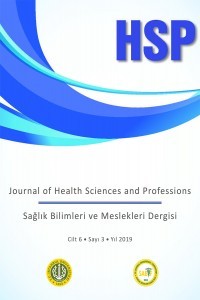Gebelik Sürecinde Fiziksel Aktivite Değişimlerinin İncelenmesi
Fiziksel aktivite ve hamilelik
Investigation of Physical Activity Changes During Pregnancy
Physical activity and pregnancy,
___
- 1. Pescatello SL, Arena R, Riebe D, Thompson PD. ACSM's Guidelines for Exercise Testing and Prescription. 9th Ed. Philadelphia: Wolters Kluwer/Lippincott Williams & Wilkins, 2014, p. 456
- 2. ACOGCommitteeOpinionNo.650: PhysicalActivity and ExerciseDuring Pregnancy and the Postpartum Period. Obstet Gynecol. 2015;126(6):e135-42.
- 3. Moore SC, Patel AV, Matthews CE. Leisure time physical activity of moderate to vigorous intensity and mortality: a large pooled cohort analysis. PLoS Med, 2012;9: e1001335
- 4. Evenson KR, Chasan-Taber L, Symons Downs D. Review of self- reported physical activity assessments for pregnancy: summary of the evidence for validity and reliability. Paediatr Perinat Epidemiol. 2012;26: 479-494
- 5. Lee JH, Park JH, Kim YJ. Sensitivity of the accelerometer as a measure- ment tool for upper extremity movement by stroke patients: a comparison with the action research arm test. J Phys Ther Sci, 2015; 27: 1053-1054
- 6. Abe Y, Sakamoto M, Nakazawa R. Relationship between joint motion and acceleration during single-leg standing in healthy male adults. J Phys Ther Sci, 2015;27: 1251-1256
- 7. Makabe S, Makimoto K, Kikkawa T. Reliability and validity of the Japanese version of the short questionnaire to assess health-enhancing physical activity (SQUASH) scale in older adults. J Phys Ther Sci, 2015;27: 517-522
- 8. Cho YK, Kim DY, Jung SY. Synergistic effect of a rehabilitation program and treadmill exercise on pain and dysfunction in patients with chronic low back pain. J Phys Ther Sci, 2015;27: 1187-1190
- 9. Evenson KR, Siega-Riz AM, Savitz DA, Leiferman JA. Vigorous leisure activity and pregnancy outcome. Epidemiology. 2002; 13(6): 653-659.
- 10. Petersen AM, Leet TL, Brownson RC. Correlates of physical activity among pregnant women in the United States. Med Sci Sports Exerc. 2005; 37(10): 1748-1753.
- 11. Oostdam N, van Poppel MN, Eekhoff EM, Wouters MG, van Mechelen W. Design of FitFor 2 study: the effects of an exercise program on insulin sensitivity and plasma glucose levels in pregnant women at high risk for gestational diabetes, BMC Pregnancy Childbirth. 2009;5:9:1
- 12. Aune D, Sen A, Henriksen T, Saugstad OD, Tonstad S6. Physical activity and the risk of gestational diabetes mellitus: a systematic review and dose-response meta-analysis of epidemiological studies. Eur J Epidemiol. 2016;31(10):967-997
- 13. Bisson M, Croteau J, Guinhouya BC, Bujold E, Audibert F. Physical activity during pregnancy and infant's birth weight: results from the 3D Birth Cohort. BMJ Open Sport Exerc Med. 2017;19:3(1):e000242
- 14. Richardsen KR, Falk RS, Jenum AK, Mørkrid K, Martinsen EW, Ommundsen Y. Predicting who fails to meet the physical activity guideline in pregnancy:a prospective study of objectively recorded physicalactivity in a population-based multi-ethnic cohort..BMC Pregnancy Childbirth. 2016; 26:16(1):186
- 15. Coll CV, Domingues MR, Hallal PC, da Silva IC, Bassani DG5, Matijasevich A. Changes in leisuretime physical activity among Brazilian pregnantwomen: comparison between two birth cohort studies (2004 - 2015). BMC Public Health. 2017: 25;17(1):119
- 16. Chandonnet N, Saey D, Alméras N, Marc I. French Pregnancy Physical Activity Questionnaire compared with an accelerometer cut point to classify physical activity among pregnant obese women. PLoS One. 2012;7(6):e38818
- 17. Aune D, Saugstad OD, Henriksen T, Tonstad S. Physical activity and the risk of preeclampsia: a systematic reviewand meta-analysis. Epidemiology. 2014;25(3):331-43
- 18. Chasan-Taber L, Schmidt MD, Roberts DE. Development and validation of a pregnancy physical activity questionnaire. Med Sci Sports Exerc, 2004;36: 1750-1760
- 19. Tosun OC, Solmaz U, Ekin A, Tosun G, Mutlu EK, Okyay E. The Turkish version of the pregnancy physical activity questionnaire: cross-cultural adaptation, reliability, and validity. Phys Ther Sci. 2015;27(10):3215-21
- 20. Harrison CL, Thompson RG, Teede HJ, Lombard CB. Measuring physical activity during pregnancy. Int J Behav Nutr Phys Act. 2011;21:8:19
- 21. Saglam M, Arikan H, Savci S. International physical activity questionnaire: reliability and validity of the Turkish version. Percept Mot Skills, 2010;111:278-284
- ISSN: 2148-7588
- Başlangıç: 2014
- Yayıncı: İstanbul Üniversitesi-Cerrahpaşa
Bornova’da Yaşayan 20 Yaş ve Üzeri Kadınlarda Üriner İnkontinans Prevelansı ve Risk Faktörleri
Ummahan YÜCEL, Aytül HADIMLI, Yeliz ÇAKIR KOÇAK, Aysun BAŞGÜN EKŞİOĞLU, Dilek SARI, Birsen KARACA SAYDAM
Okul Yaralanmalarını Önlemede Sağlık İnanç Modelinin Etkisi
Ameliyathanede Ergonomik Faktörler ve Çalışan Güvenliği
Doğum Yapan Kadınların Doğumdan Memnuniyeti ve Etkileyen Faktörler
Nevin ÇITAK BİLGİN, Bedriye AK, Dilek COŞKUNER POTUR, Fatma AYHAN
Ameliyat Geçiren Hastalarda Konfor Düzeyi ve Etkileyen Faktörlerin İncelenmesi
Pınar BÜYÜKÜNAL ŞAHİN, Selda RIZALAR
Gebelik Sürecinde Fiziksel Aktivite Değişimlerinin İncelenmesi
Özge ÇELİKER TOSUN, Recep Emre OKYAY
Sihirli Gülüşlerle Yaşama Bir Dokunuş: Mizah Terapi
Zeynep ERDOĞAN, Mehmet Ali KURCER, Beyhan BUDAK, Selim AYDEMİR
